July 2025
The global smart furniture market size was valued at USD 218.65 billion in 2024 and is estimated to hit around USD 850.55 billion by 2034, growing at a compound annual growth rate (CAGR) of 14.55% during the forecast period 2025 to 2034.The consumer demand for technology-connected furniture has increased, driving the global smart furniture market. Rising trend for smart homes, fueling demand for smart furniture, and driving the market.
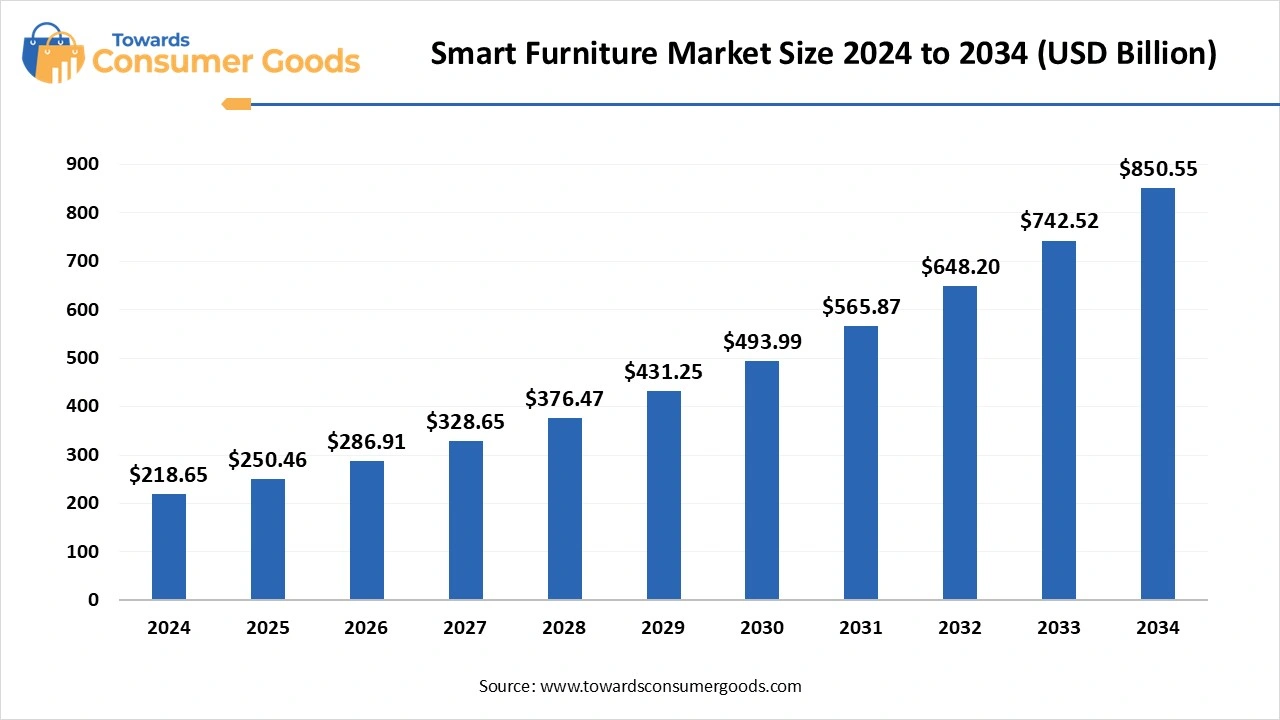
The global smart furniture market is transforming rapidly due to increased demand for advanced technology and connected features in furniture. The smart furniture with AI and IoT devices integration is gaining popularity. Factors like rapid urbanization, small living spaces, growing tech-savvy demands, remote work culture, and increased disposable income are driving the adoption of smart furniture.
Additionally, groinwg adoption of smart home culture, fueling the need for smart furniture to be integrated with other home systems. Manufacturers are focusing on advancing features of smart furniture like automation, connectivity, and energy-efficient systems. The rising consumer preference for sustainable solutions is fostering innovative approaches in the market.
The increased demand for multifunctional furniture is the major driver of the market. Urbanization growth and small living spaces has led consumer shift toward multifunctional furniture. The multifunctional furniture designs for flexibility, with a major focus on user experiences and needs, and integrated technologies, like wi-fi connectivity, sensors, and voice assistance.
Manufacturers are focusing on developing sustainable multifunctional furniture to comply with rising consumer preference for eco-friendliness. Automation, adjustable & modular design, ergonomic designs, and smart sensors are the most preferred features in multifunctional furniture.
| Report Attributes | Details |
| Market Size in 2025 | USD 250.46 Billion |
| Expected Size by 2034 | USD 850.55 Billion |
| Growth Rate from 2025 to 2034 | CAGR 14.55% |
| Base Year of Estimation | 2024 |
| Forecast Period | 2025 - 2034 |
| High Impact Region | North America |
| Segment Covered | By Product, By Application |
| Key Companies Profiled | Inter Ikea Systems B.V., Steelcase Inc, HNI Corporation, Sobro, Desktronik, Sleep Number Corporation, Herman Miller, Inc., Hi-Interiors srl, Krini Furniture Pvt Ltd, Nitz Engineering GmbH |
The rising demand for smart office furniture, driven by increased remote jobs, increased adoption of smart home technology in office settings, and demand for flexible and ergonomic workspaces, holds potential opportunities for the global market growth. Consumers with a work-from-home culture seeking enhanced comfort and functionality in smart furniture, that’s the impact on productivity. Additionally, the rapid growth of tech-savvy workspace adoption, fostering demands for smart furniture with the integration of modern and technologically advanced work environments to improve employee productivity and comfort.
The integration of cutting-edge technologies in furniture increased their cost. Smart furniture is expensive compared to conventional furniture, due to its advanced features and technologies. Integration of technologies like voice assistants, wi-fi connection, and sensors increased the production cost of smart furniture. Additionally, smart furniture requires high investments in research & development. The high-quality materials used in smart furniture can also be expensive, boosting their initial cost. High upfront cost can hamper adoption, particularly among cost-conscious consumers.
Which Region Dominates the Smart Furniture Market ?
The North America smart furniture market size was valued at USD 70.89 billion in 2024 and is expected to be worth around USD 276.17 billion by 2034, exhibiting a compound annual growth rate (CAGR) of 14.57% over the forecast period 2025 to 2034.
North America dominates the global smart furniture market due to high consumer preference for smart homes, IoT integration, and high disposable income. North America is well-known for the early adoption of advanced technologies. Growing hybrid work culture, smart offices, and accessibility of cutting-edge technologies, driven by the presence of key market vendors, are fostering market growth.
North America has modern consumers who prioritize wellness and self-care. the health benefits associated with smart furniture make them ideal for health-conscious consumers. Additionally, the growing surge in sustainable furniture with cutting-edge connectivity is expected to bring significant innovation to the market.
The U.S. is a major player in the regional market, driving market growth due to a large population, high adoption of smart homes, and increasing disposable income. The consumer preference for convenience and comfortable home appliances is driving a shift toward smart furniture. Additionally, high urbanization is driving the need for multifunctional furniture, contributing to market growth.
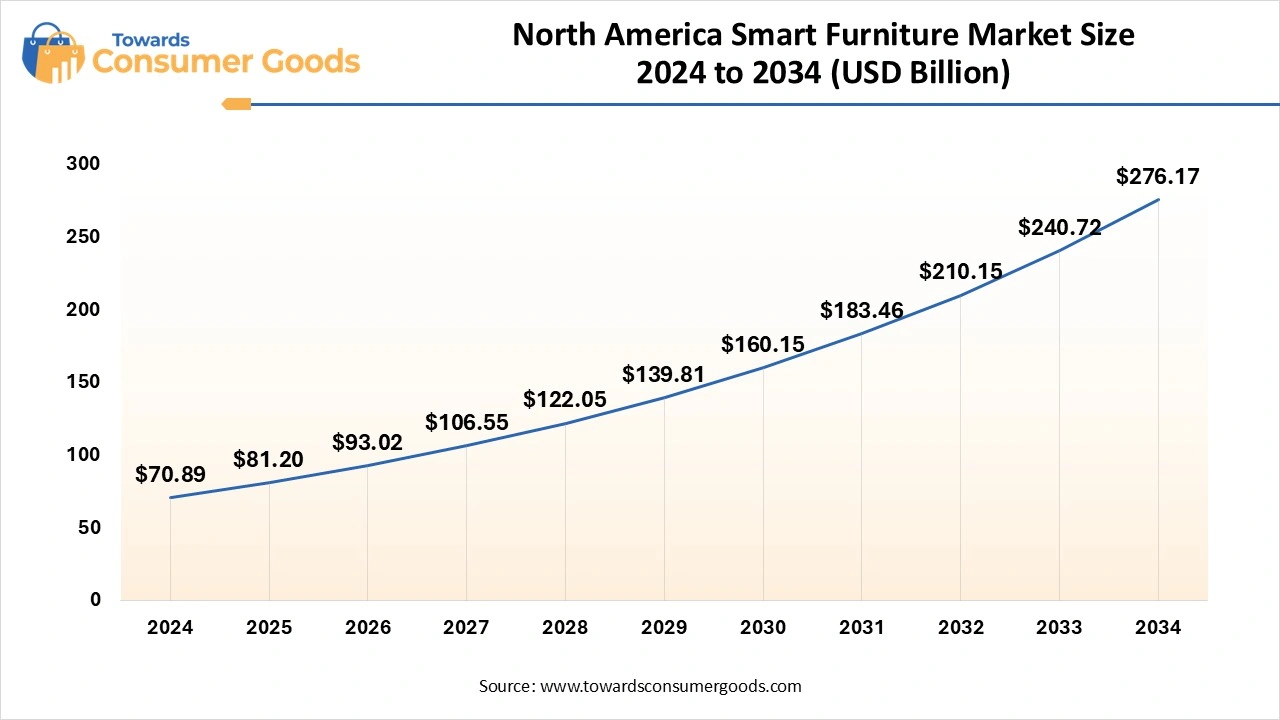
Asia Pacific Smart Furniture Market Trends
Asia is the fastest-growing region in the global market, growth driven by factors like rapid urbanization, a large middle-class population, and increased consumer shift toward adoption of smart home technologies. The rapid urbanization of Asia has increased consumer demand for space-saving and multifunctional furniture. Government initiatives in countries like China, Japan, India, and South Korea are promoting the adoption of smart home solutions through smart city development and digitalization projects. However, the 2025 U.S. tariff is impacting the export of Asian countries' goods, especially China.
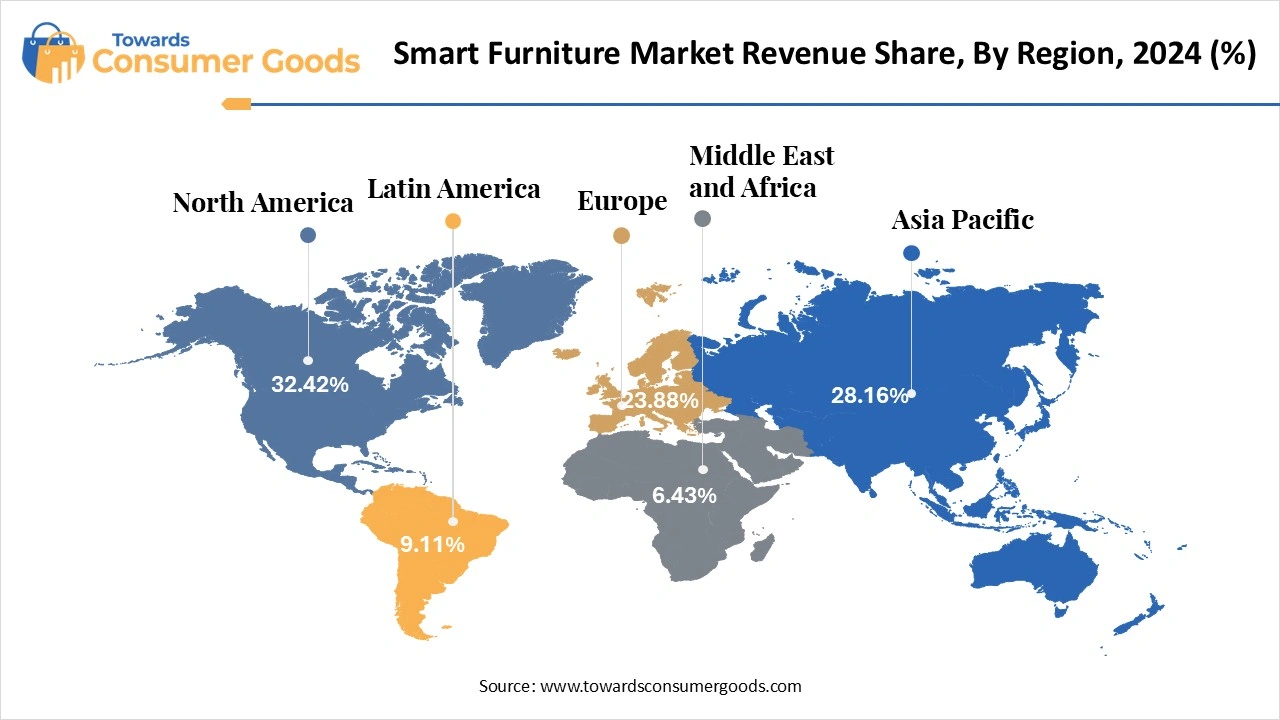
China is the major player in the Asian market due to the country's large population, initiatives in technology advancements, rapid urbanization, and demand for smart home solutions. China has a large middle-class population, increasing adoption of smart home devices, driven by rising disposable income. Government initiatives like “Make in China” are fostering the manufacturing of smart furniture. The large cost-effective manufacturing base of China makes it to leader in the regional market.
India is a significant player in the regional market, growth driven by an expanding middle-class population and a burgeoning tech-savvy population. Rapid urbanization, increased disposable income, and the adoption of smart home environments are fostering market growth.
How did Smart Desks Segment Dominate the Market in 2024?
The smart desks segment dominated the market in 2024, due to increased demand for technologically advanced and ergonomic workspaces. Both commercial and residential both are the major consumers of smart desks. The rise of remote work culture and awareness of health benefits associated with smart desks are fostering their adoption. Consumers are seeking higher adjustable, built-in charging ports, IoT-integrated, and wireless connectivity smart desks. Modern consumers and businesses are highly adopting smart desks.
The smart table segment is expected to grow fastest in revenue in the forecast period due to versatile and technology-integrated tables. The demand for versatile tables, with touch controls, speaker integrated, and wireless charging, has increased among modern consumers. Smart tables offer more convenience and efficiency. The tables with advanced features like control over smart home devices and space-saving capabilities are gaining rapid popularity.
Which Application Segment Held the Largest Market Revenue in Smart Furniture Market?
In 2024, the residential segment held the largest market revenue due to increased adoption of smart homes and demand for smart devices, including furniture. The smart home system is driving the need for convenience and cutting-edge technology-integrated devices to control home systems. Smart furniture with IoT device integration is gaining popularity for smart houses. Growing urbanization and infrastructural developments are driving the adoption of smart furniture, including smart sofas, chairs, tables, beds, and desks for homes.
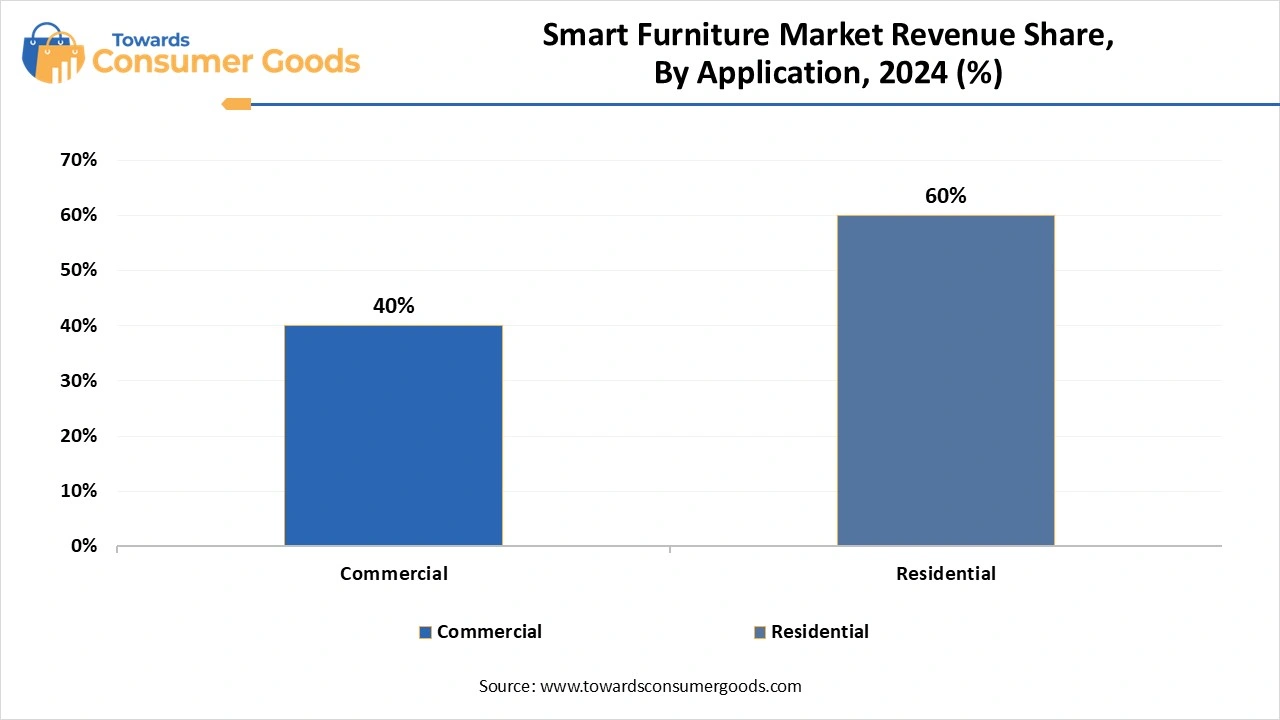
Additionally, rising availability of disposable income allows homeowners to spend on advanced devices, like smart furniture.
The commercial segment is the second-largest segment, leading the market. The segment growth is driven by to rising adoption of smart furniture in offices. The growth of smart offices has created demand for smart devices like furniture, aligning with the integration of advanced technologies. Businesses are seeking smart furniture to integrate with existing systems, to enhance employee comfort, a better work environment, and productivity. Smart seating furniture, desks, and meeting tables are widely used in the commercial sector.
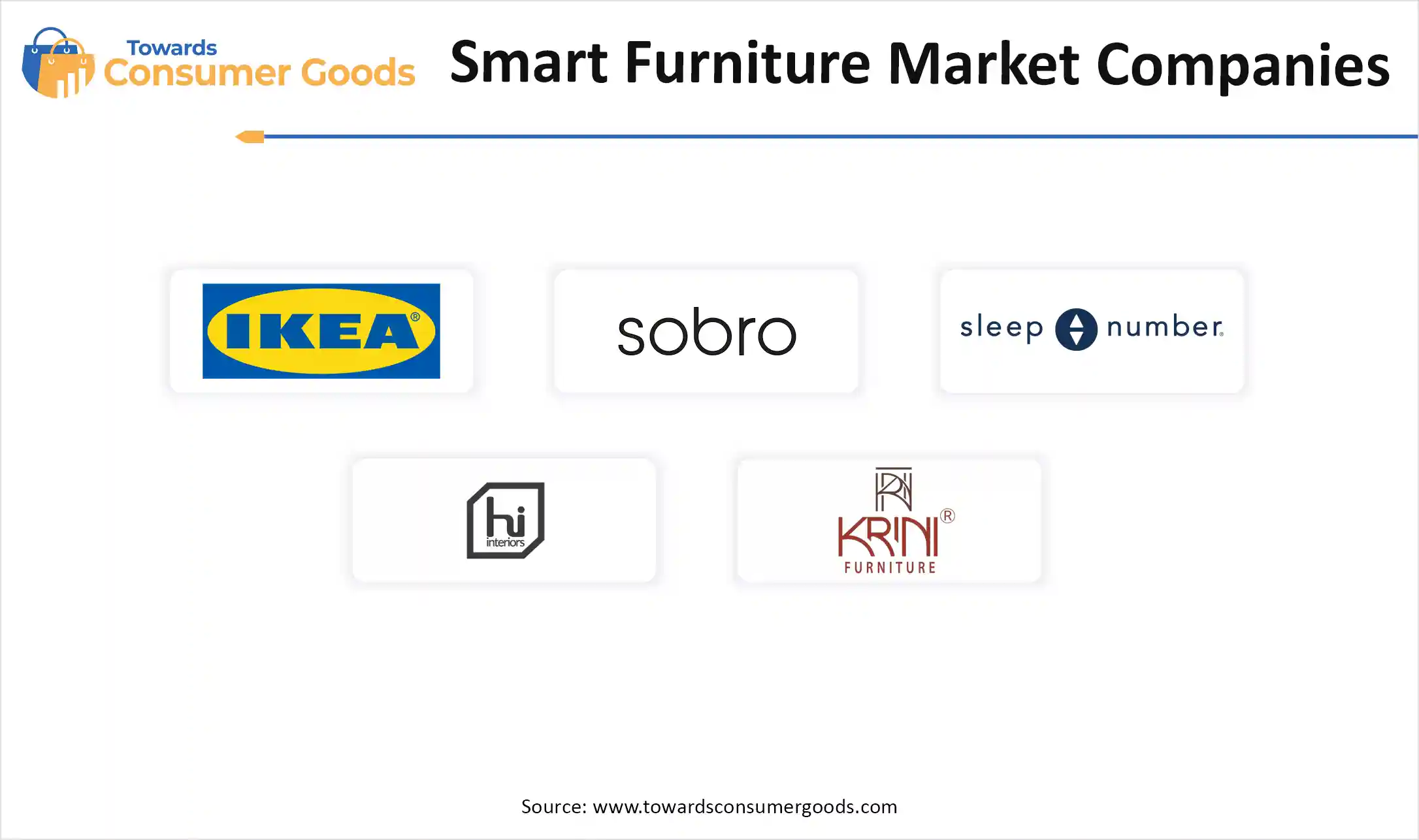
By Product
By Application
By Region
Based on comprehensive market projections, the global smart kitchen market size accounted for USD 20.96 billion in 2024, grew to USD 24.96 billion in ...
July 2025
July 2025
July 2025
July 2025